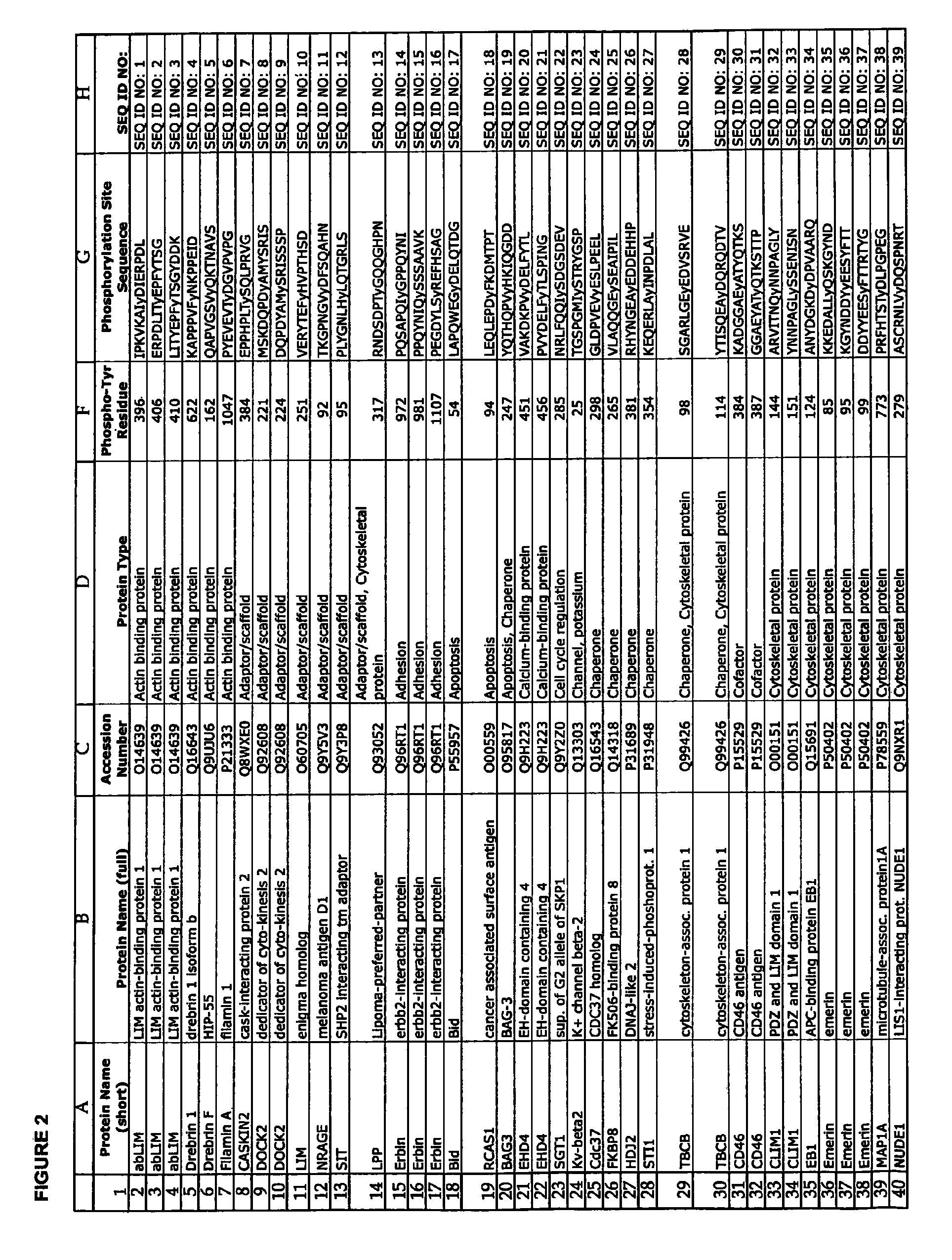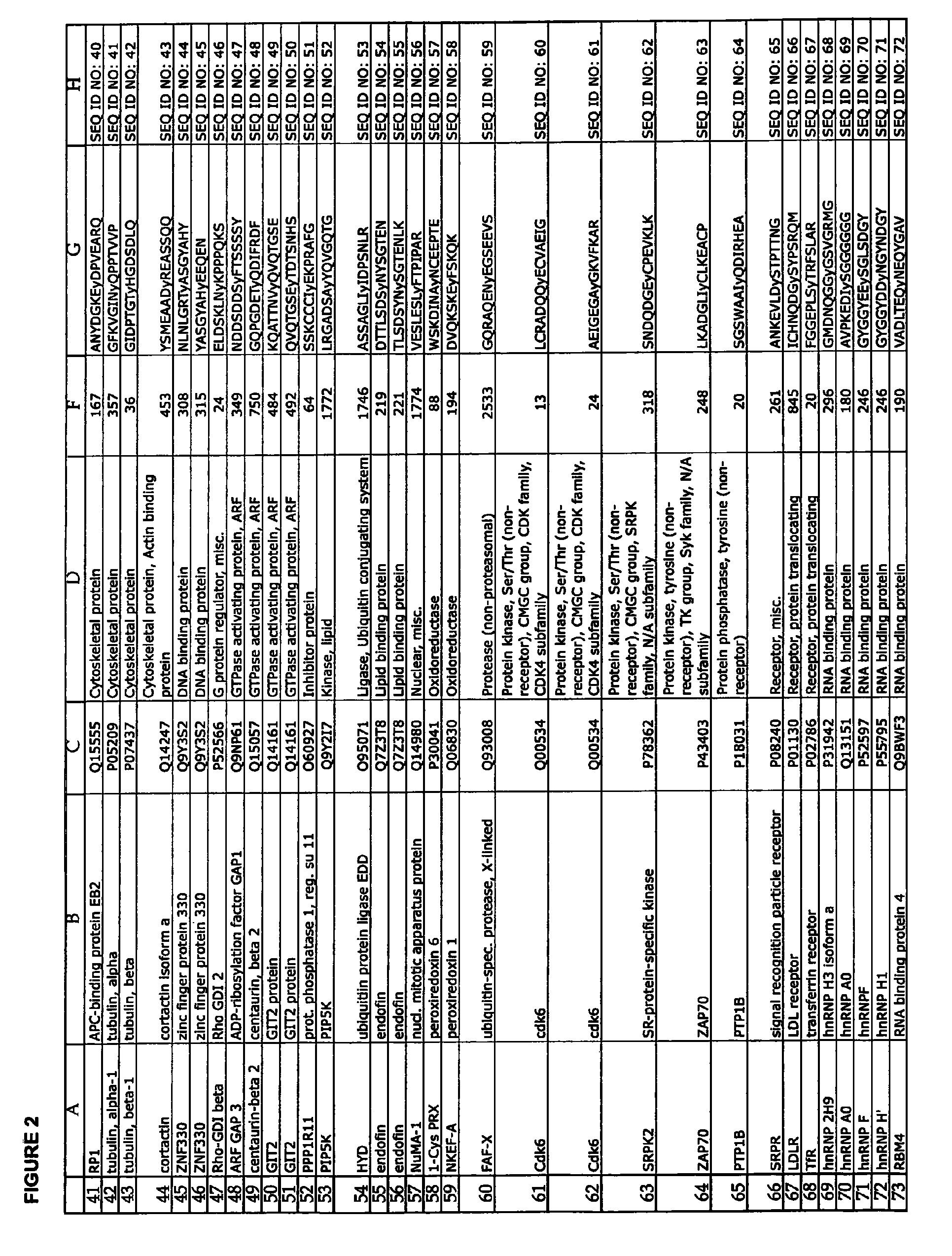Reagents for the detection of protein phosphorylation in T-cell receptor signaling pathways
a t-cell receptor and signaling pathway technology, applied in the field of antibodies and peptide reagents for the detection of protein phosphorylation, and to protein phosphorylation in cancer, can solve the problems of unfavorable cellular modification system, undeveloped technology, and inability to fully unravel the complexity of the cellular modification system
- Summary
- Abstract
- Description
- Claims
- Application Information
AI Technical Summary
Problems solved by technology
Method used
Image
Examples
example 1
Isolation of Phosphotyrosine-Containing Peptides from Extracts of Activated Jurkat Cells and Identification of Novel Phosphorylation Sites
[0148]In order to discover previously unknown T-cell receptor signaling protein phosphorylation sites, IAP isolation techniques were employed to identify phosphotyrosine-containing peptides in cell extracts from Jurkat cells treated with pervanadate in order to stimulate tyrosine phosphorylation.
[0149]Tryptic phosphotyrosine peptides were purified and analyzed from extracts of the Jurkat cell line as follows. Cells were cultured in RPMI medium supplemented with 10% bovine serum and penicillin / streptomycin. Cells were cultured to a density of 1.2×106 cells / ml and were washed in PBS at room temperature, then resuspended in PBS at 7×107 cells / ml. After preincubation at 37° C. for 20 min, calyculin A and sodium pervanadate were added to final concentrations of 50 ng / ml and 1 mM, respectively, and cells were incubated for 20 min at 37° C. After centrif...
example 2
Production of Phospho-specific Polyclonal Antibodies for the Detection of T-cell Receptor Signaling Protein Phosphorylation
[0159]Polyclonal antibodies that specifically bind a T-cell receptor signal transduction protein only when phosphorylated at the respective phosphorylation site disclosed herein (see Table 1) are produced according to standard methods by first constructing a synthetic peptide antigen comprising the phosphorylation site sequence and then immunizing an animal to raise antibodies against the antigen, as further described below. Production of exemplary polyclonal antibodies is provided below.
A. Cdk6 (Tyrosine 24).
[0160]A 15 amino acid phospho-peptide antigen, AEIGEGAy*GKVFKAR (SEQ ID NO: 61) (where y*=phosphotyrosine), that corresponds to the tyrosine 24 phosphorylation site in human Cdk6 kinase (see Row 62 of Table 1), plus cysteine on the C-terminal for coupling, is constructed according to standard synthesis techniques using, e.g., a Rainin / Protein Technologies, ...
example 3
Production of Phospho-Specific Monoclonal Antibodies for the Detection of T-Cell Receptor Signaling Protein Phosphorylation
[0167]Monoclonal antibodies that specifically bind a T-cell receptor signal transduction protein only when phosphorylated at the respective phosphorylation site disclosed herein (see Table 1) are produced according to standard methods by first constructing a synthetic peptide antigen comprising the phosphorylation site sequence and then immunizing an animal to raise antibodies against the antigen, and harvesting spleen cells from such animals to produce fusion hybridomas, as further described below. Production of exemplary monoclonal antibodies is provided below.
A. Cdk6 (Tyrosine 13).
[0168]A 15 amino acid phospho-peptide antigen, LCRADQQY*ECVAEIG (SEQ ID NO: 60) (where y*=phosphotyrosine) that corresponds to the tyrosine 13 phosphorylation site in human Cdk6 kinase (see Row 61 of Table 1), plus cysteine on the C-terminal for coupling, is constructed according to...
PUM
| Property | Measurement | Unit |
|---|---|---|
| concentration | aaaaa | aaaaa |
| concentrations | aaaaa | aaaaa |
| temperature | aaaaa | aaaaa |
Abstract
Description
Claims
Application Information
 Login to View More
Login to View More - R&D
- Intellectual Property
- Life Sciences
- Materials
- Tech Scout
- Unparalleled Data Quality
- Higher Quality Content
- 60% Fewer Hallucinations
Browse by: Latest US Patents, China's latest patents, Technical Efficacy Thesaurus, Application Domain, Technology Topic, Popular Technical Reports.
© 2025 PatSnap. All rights reserved.Legal|Privacy policy|Modern Slavery Act Transparency Statement|Sitemap|About US| Contact US: help@patsnap.com



